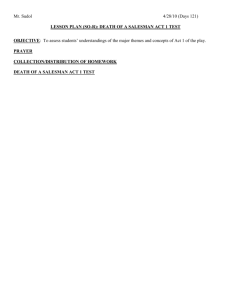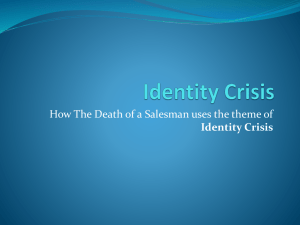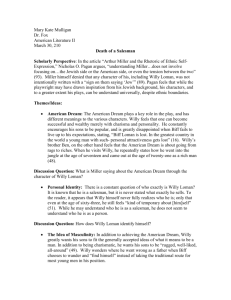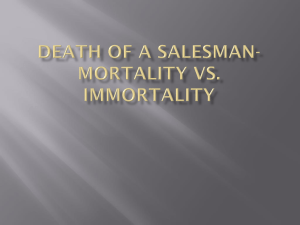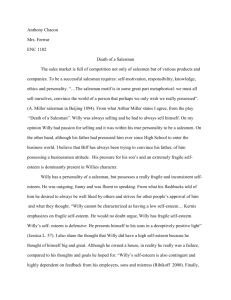Is Death of a Salesman a tragedy and Willy Loman a tragic hero, or
advertisement
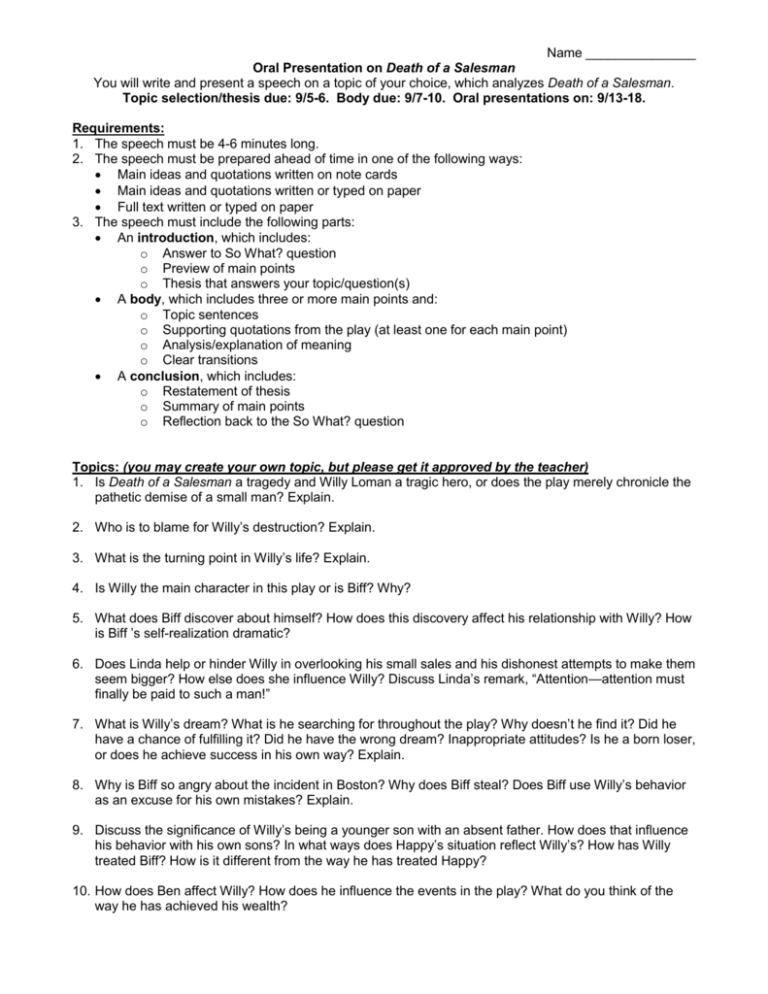
Name _______________ Oral Presentation on Death of a Salesman You will write and present a speech on a topic of your choice, which analyzes Death of a Salesman. Topic selection/thesis due: 9/5-6. Body due: 9/7-10. Oral presentations on: 9/13-18. Requirements: 1. The speech must be 4-6 minutes long. 2. The speech must be prepared ahead of time in one of the following ways: Main ideas and quotations written on note cards Main ideas and quotations written or typed on paper Full text written or typed on paper 3. The speech must include the following parts: An introduction, which includes: o Answer to So What? question o Preview of main points o Thesis that answers your topic/question(s) A body, which includes three or more main points and: o Topic sentences o Supporting quotations from the play (at least one for each main point) o Analysis/explanation of meaning o Clear transitions A conclusion, which includes: o Restatement of thesis o Summary of main points o Reflection back to the So What? question Topics: (you may create your own topic, but please get it approved by the teacher) 1. Is Death of a Salesman a tragedy and Willy Loman a tragic hero, or does the play merely chronicle the pathetic demise of a small man? Explain. 2. Who is to blame for Willy’s destruction? Explain. 3. What is the turning point in Willy’s life? Explain. 4. Is Willy the main character in this play or is Biff? Why? 5. What does Biff discover about himself? How does this discovery affect his relationship with Willy? How is Biff ’s self-realization dramatic? 6. Does Linda help or hinder Willy in overlooking his small sales and his dishonest attempts to make them seem bigger? How else does she influence Willy? Discuss Linda’s remark, “Attention—attention must finally be paid to such a man!” 7. What is Willy’s dream? What is he searching for throughout the play? Why doesn’t he find it? Did he have a chance of fulfilling it? Did he have the wrong dream? Inappropriate attitudes? Is he a born loser, or does he achieve success in his own way? Explain. 8. Why is Biff so angry about the incident in Boston? Why does Biff steal? Does Biff use Willy’s behavior as an excuse for his own mistakes? Explain. 9. Discuss the significance of Willy’s being a younger son with an absent father. How does that influence his behavior with his own sons? In what ways does Happy’s situation reflect Willy’s? How has Willy treated Biff? How is it different from the way he has treated Happy? 10. How does Ben affect Willy? How does he influence the events in the play? What do you think of the way he has achieved his wealth? 11. Willy is proud of putting up the living-room ceiling and making a concrete porch. How is the image of working with his hands carried through the play? Why, then, doesn’t Willy think highly of being a carpenter? 12. How and why do Willy’s illusions differ from reality? In what ways does Willy contradict himself, and why is his inconsistent? 13. Trace one (or more) of the symbols used throughout the play. Explain its meaning (what it represents) and how Miller uses it to communicate an important theme. Content Organization Style and Language Minimal -demonstrates limited understanding of Death of a Salesman -responds to few or no aspects of the chosen topic -provides little detail, development, and support -reflects little imagination, creativity, and sensitivity Basic -demonstrates partial understanding of Death of a Salesman -responds to some aspects of the chosen topic -provides some detail, development, and support. -reflects some imagination, creativity, and sensitivity Proficient -demonstrates sufficient understanding of Death of a Salesman -responds to most aspects of the chosen topic -provides adequate detail, development, and support -reflects imagination, creativity, and sensitivity Advanced -demonstrates perceptive understanding of Death of a Salesman -responds to all aspects of the chosen topic -provides substantial detail, development, and support -reflects deep imagination, creativity, and sensitivity -less than 2 minutes -generally disorganized, unclear, and/or incoherent -quotations are seldom or never incorporated into analysis -2 or more minutes -partially organized, clear, and/or coherent -quotations are partially incorporated into analysis -3 or more minutes -mostly well organized, clear, and coherent -quotations are smoothly incorporated into analysis Some of the following are included: -intro with answer to the So What? question, preview of main points, thesis that answers chosen topic -body with three or more main points, one or more quotations to support each main point, and smooth transitions -conclusion with restatement of thesis, summary of main points, and reflection back to the So What? question Most of the following are included: -intro with answer to the So What? question, preview of main points, thesis that answers chosen topic -body with three or more main points, one or more quotations to support each main point, and smooth transitions -conclusion with restatement of thesis, summary of main points, and reflection back to the So What? question -4-6 minutes -consistently well organized, clear, and coherent -quotations are expertly and seamlessly incorporated into analysis -Presenter seems somewhat prepared and rehearsed. -Eye contact and facial expressions are limited or unfitting. -Vocal variety, gestures, posture, and movements are somewhat ineffective. -Speech is clear, distinct, fluent, and loud enough throughout some of the presentation. -Presenter seems mostly prepared and rehearsed. -Eye contact and facial expressions support the purpose. -Vocal variety, gestures, posture, and movements are appropriate and effective. -Speech is clear, distinct, fluent, and loud enough throughout most of the presentation. Few of the following are included: -intro with answer to the So What? question, preview of main points, thesis that answers chosen topic -body with three or more main points, one or more quotations to support each main point, and smooth transitions -conclusion with restatement of thesis, summary of main points, and reflection back to the So What? question -Presenter seems lacking in preparation and rehearsal. -Eye contact is very limited, and facial expressions are unvaried. -Vocal variety, gestures, posture, and movements are limited and/or distracting. -Speech cannot be understood, heard and/or lacks fluency throughout much of the presentation. All of the following are included: -intro with answer to the So What? question, preview of main points, thesis that answers chosen topic -body with three or more main points, one or more quotations to support each main point, and smooth transitions -conclusion with restatement of thesis, summary of main points, and reflection back to the So What? Question -Presenter seems wellprepared and wellrehearsed. -Eye contact and facial expressions enhance the purpose. -Vocal variety, gestures, posture, and movements are poised and natural; they enhance the presentation. -Speech is clear, distinct, fluent, and loud enough throughout the presentation.

